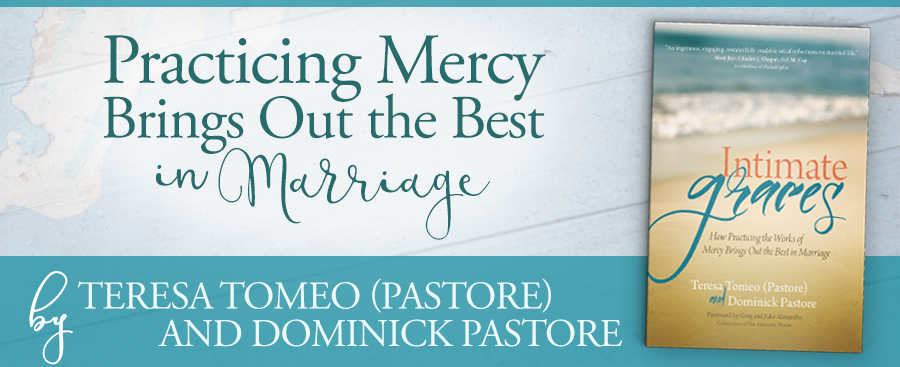Our Attitude Makes a Difference
John: I Say “White”; He Says “Black”
A few years ago I visited my sister and her husband who live in Italy. During a quiet moment when she and I were alone on her balcony overlooking the garden, she said with a frustrated tone in her voice, “How can I go on? He is driving me crazy.” She was referring to her husband. “There are days I cannot stand him. I say ‘white’; he says ‘black.’ I say, ‘Let’s go right’; he wants to go left.” Then, after a long pause, she added, “I guess this is life. We are different. He is my cross, and I am his.”
She continued, “John, don’t misunderstand me. There are many good days, and I am grateful for them. I love him. But when things get tough, I pray a lot for peace, and then I carry on. What else can I do?”
The conversation in the story above reminded me of how our attitudes affect how we perceive and tolerate suffering. Faith can give meaning to our pains. There are times when spouses are indeed each other’s crosses because of their imperfections. But through faith and prayer, husband and wife can live with each other’s imperfections and join their discomfort to Christ’s suffering in his work of salvation (CCC, 1521).
There are some people who think that if a couple is unhappy, it is better for them and for their children if they divorce. The fact is that, unless there is abuse or violence in the marriage, divorce is never the solution to our unhappiness. A group of leading scholars headed by the University of Chicago sociologist Linda Waite studied couples who were experiencing difficulties in their relationship. They found that two-thirds of the spouses who stayed together in spite of being unhappy reported that their marriages were happier five years later. They also found no evidence to indicate that those who divorced were any happier than those who stayed married. Even those who remarried were not happier. Researchers concluded that what kept couples together in spite of their difficulties was their commitment and their willingness to work at their relationship. Their commitment prompted them to invest their efforts in overcoming their problems. In so doing, they experienced greater satisfaction in their relationship.
This was the case with Mark, a friend of ours. He shared that after fifteen years of marriage, he and his wife found it difficult to trust and to be honest with each other. They separated temporarily. She sought help from a therapist; he went to the parish priest. The priest asked Mark, “Is this the first step toward divorce, or the last step to save a marriage?” He responded, “I do not want a divorce. I want to save my marriage.” The priest told Mark to work at the marriage with the intent of saving it and to ask for God’s help in prayer. Both of them worked hard at rebuilding trust and their relationship. After three months, Mark and his wife got back together. They have now been married for twenty-five years and are involved in helping other couples strengthen their marriages.
In the gospels, Jesus invites us to take up our cross and follow him. Through the eyes of faith, we can see that our suffering has meaning. As Jesus carried his cross, we are to carry ours. We learn from the Catechism of the Catholic Church that Christ dwells with spouses and gives them the strength to take up their crosses and follow him (CCC, 1642).
There is no cross, big or small, in our life which the Lord does not share with us. —Pope Francis, Tweet from World Youth Day, July 2013
The value of seeing our discomfort and suffering through the eyes of faith is that it allows us to turn to God for guidance and strength. In prayer, couples can look at their marriage from a wider perspective, God’s perspective. With the help of God’s grace, they learn to cope with the discomfort and to take action, when necessary, even if sometimes it requires rocking the boat a little.
This spiritual outlook on life is very helpful in building your marriage so that it becomes your home. However, finding meaning in suffering is not a reason for tolerating abuse or living in abusive relationships. When abuse is present, your physical and emotional safety should be the main concern. In these cases, you need the help of professionals to keep you safe and to heal from the abuse.
What thoughts come to mind when you read that suffering can have a spiritual value when seen through the eyes of faith?
The Power of Physical Touch
Physical touch can be a tool for healing. Gary Chapman writes in his book The Five Love Languages, “For some individuals, physical touch is their primary love language. Without it, they feel unloved.”7 Physical touch is a powerful ingredient in a married couple’s life. Touch not only expresses love but it also heals.
In Michelangelo’s depiction of creation on the ceiling of the Sistine Chapel, God’s hand reaches out to touch Adam’s hand. It is through that contact that Adam feels God’s love and becomes alive. From the book of Genesis in the Bible, we know that as long as Adam kept that contact with God he was happy. But when Adam and Eve decided to let go of God’s hand because they thought that they could be just as happy on their own, death and suffering entered the world. Staying connected with God brings life and happiness; disconnecting from him brings death and sorrow.
The image of God’s hand reaching out to Adam captures the essence of every marital relationship. Physical touch in marriage is an expression of emotional and spiritual connection—an expression of love. Researchers are also finding that physical touch has a soothing and healing effect. A study of young married couples conducted at Brigham Young University found that the caring touch of a spouse lowers stress hormones and blood pressure in the other.
Prayer Tool
Praying to Mary, the Blessed Mother
Prayer is also a tool for healing. Catholics often turn to Mary, the Mother of God, for courage and for comfort in moments of difficulty. Our Catholic tradition honors Mary in a particular way because she is the Mother of our Savior, Jesus. Some non-Catholic faith traditions find it hard to understand our Catholic devotion to Mary. Catholics do not worship Mary. Only God deserves worship. We pray to Mary as if we were talking to our spiritual mother. We ask her to intercede on our behalf with her son, Jesus.
Two prayers that Catholics use to honor Mary are the Hail Mary and the Rosary. Make it a habit to pray both of these prayers.
Here are the words of the Hail Mary:
Hail Mary, full of grace. The Lord is with thee.
Blessed art thou amongst women, and blessed is the fruit of thy womb, Jesus.
Holy Mary, Mother of God, pray for us sinners, now and at the hour of our death. Amen.
This excerpt from The Joined by Grace Couple’s Book is reprinted with permission of Ave Maria Press.
John Bosio is a former marriage and family therapist, director of religious education, and diocesan family life coordinator. He and his wife, Teri, wrote Joined by Grace, a marriage preparation program from Ave Maria Press.







